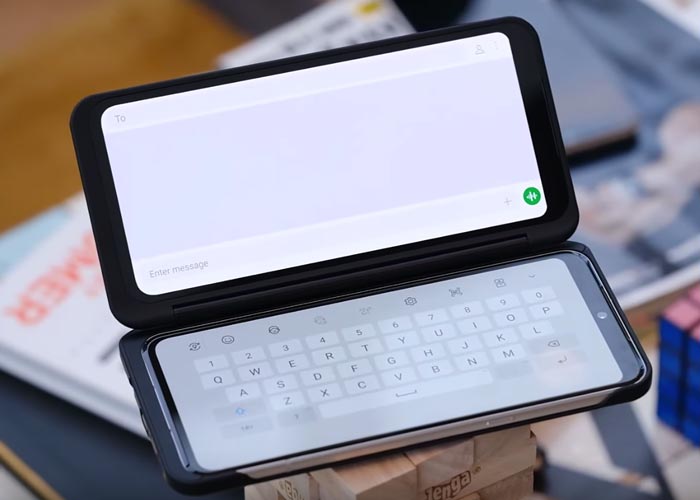NEW: LG V60 Smartphone with 8K video and Dual Screens
The LG have always aimed at more serious photographers and video-shooters with their V-range of phones. Their native app allows extensive manual control and some form of “Log” colour profile. Recently, they also added a dual screen – which is 2 screens which fold like a mini laptop.
In addition, the new LG V60 competes with the Samsung S20 phones by offering up to 8K video resolution. They have also retained the 3.5mm jack, which is good for those of us who like to use external mics.
The V60 comes with Qualcomm’s Snapdragon 865 chipset and supports 5G connectivity. This will mostly be optimised for Sub-6 5G networks. However, a more expensive model is coming, designed for ultra-fast millimeter-wave data speeds. Inbuilt storage is 128GB, plus an optional microSD expansion, and 8GB of RAM. LG says the V60’s 5000mAh battery lasts 30 percent longer than the G8x.
Dual Screen
I like the idea of a dual removable screen (over a folding screen) to turn the phone into a kind of mini-laptop. I’ve always been on the lookout for a device which allows me to write blogs and screenplays on the go. So the idea of setting up a screenwriting program like Final Draft on my phone and using it with the dual screen is a neat one.

Larger Camera Sensor
The LG V60 ThinQ has a larger 1/1.7-inch sensor for the primary 64-megapixel f/1.8 camera. This is the same size as the recent Huawei phones and Sony’s latest and just behind the Galaxy S20.
One disappointment is the lack of a telephoto lens, with the V60 coming with only a wide and a regular lens. However, the camera uses pixel binning to help combat noise and produce 16MP images. The 13-megapixel ultrawide provides a 117-degree field of view. Max digital zoom is x10.
More 8K Video
The LG V60 follows the Samsung S20 in providing up to 8K video resolution, which you can watch if you buy one of LG’s 8K TVs. Yes, it should be no surprise that 2 major manufacturers of 8K TVs (LG and Samsung) have brought out 8K capturing smartphones. The LG Nano 9 series 8K TV will set you back $4999.
Yes but 5 years from now, we’ll all have 8K TVs… possibly.
“Voice Bokeh”
Not content with the term Bokeh expanding from meaning blurry lights in the background to any kind of faintly blurred background, LG have decided it needs to refer to the phone’s ability to adjust the audio as it’s being recorded to emphasise voices. The device achieves this by doing something to background noise.
As someone who used to be a sound engineer, I’m always a bit suspicious of tech that makes claims like this. Because if this was a serious thing, wouldn’t pro kit be using it? But I’m all ears in anticipation of hearing the results.
The LG V60 can also capture 3D audio with its 4 microphones (top, bottom, left, and back).
HDR10+
In manual video mode, you can set the V60 to record in HDR10+ for a greater dynamic range (presuming your video is played via an HDR10+ supporting device or platform).
And as with previous LG V phones, the device comes with a native camera app which provides extensive manual control for video shooting. This is actually something not too common with smartphones, although Samsung have brought back their video pro mode for recent devices.
While LG have made made effort to give video more options that other consumer devices, right now only Sony have gone “all in” on devices aimed directly at professional filmmakers. Not that Sony are ignoring consumers, just that – like with their mirrorless cameras – they’re taking consumer cameras seriously.
Eager to learn more?
Join our weekly newsletter featuring inspiring stories, no-budget filmmaking tips and comprehensive equipment reviews to help you turn your film projects into reality!
Simon Horrocks
Simon Horrocks is a screenwriter & filmmaker. His debut feature THIRD CONTACT was shot on a consumer camcorder and premiered at the BFI IMAX in 2013. His shot-on-smartphones sci-fi series SILENT EYE featured on Amazon Prime. He now runs a popular Patreon page which offers online courses for beginners, customised tips and more: www.patreon.com/SilentEye

